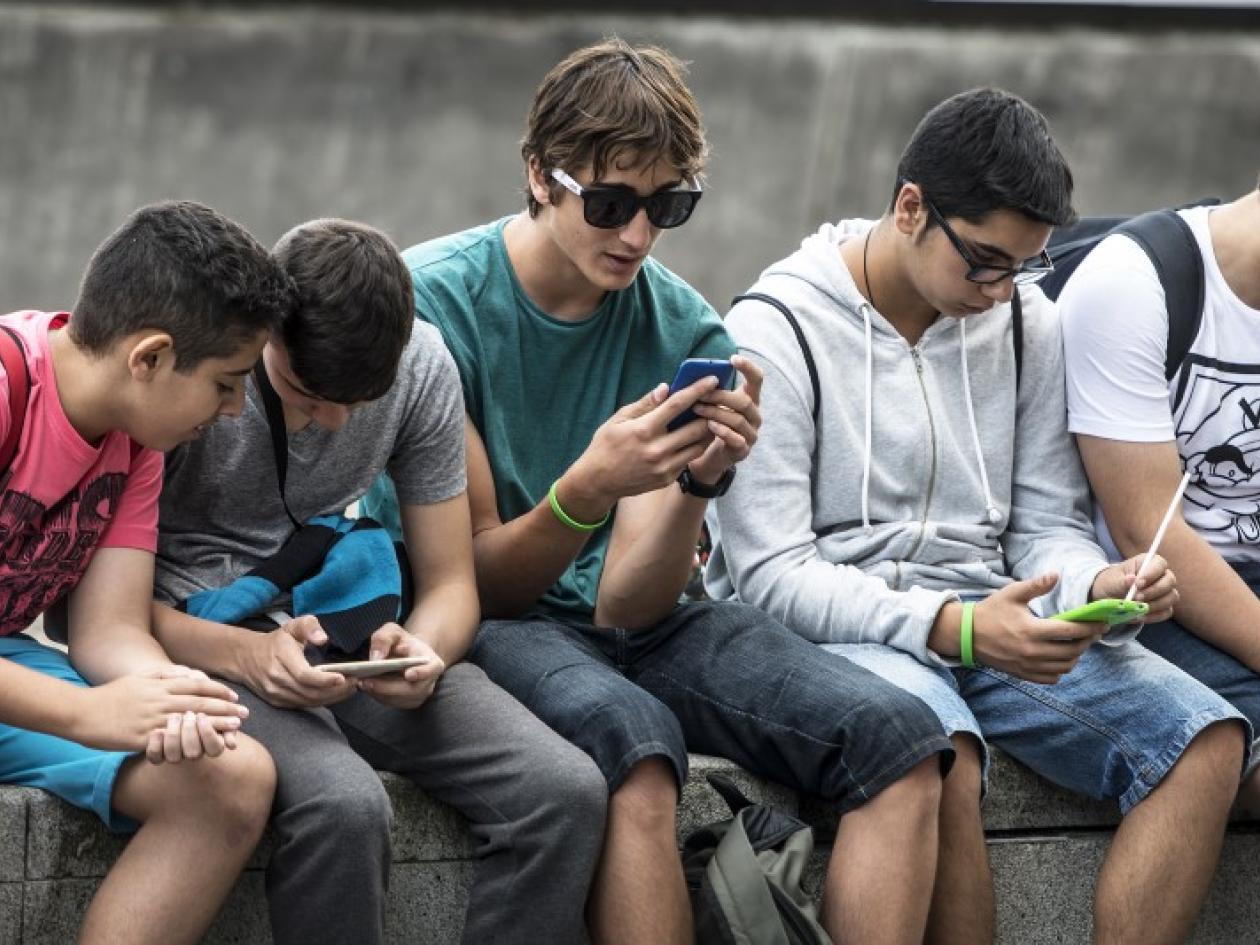In the words of Andrew Przybylski, Professor of Human Behaviour and Technology at the Oxford Internet Institute, “Fears that the digital world is harmful have proliferated for years.” Do we need to worry about our children’s screen time, though?
Or, indeed, our own? Are we all making ourselves miserable? Will we end up like the humans in WALL-E, gliding around on robotic beds, gazing at screens? Or is it not going to have much effect at all? As with so much in life, if we want to be better informed, we need to look at the evidence…
Early evidence
Some early evidence – the first paper on this subject using our data dates back to 2015 – suggested that spending more time on social media reduces children’s life satisfaction, except for their friendships, and that girls suffer more than boys.
Similarly, there was a lot of media coverage for a release from the Office for National Statistics on national wellbeing. Using our data on children’s strengths and difficulties, this showed “a clear association between longer time on social websites and higher total difficulties scores”.
In 2018, a paper found gender differences: “greater social media interaction at age 10 was associated with lower levels of well-being at later ages among females”. The authors were careful, though, to point out that their findings were not definitive, saying they “contribute to the debate on causality”.
Did these findings attract attention, though, simply because they tapped into our fears? Because, to quote a phrase popular on social media, “confirmation bias is one hell of a drug”?
A change in direction
A year later, research published in PNAS (Proceedings of the National Academy of Sciences) suggested something quite different. The links between social media use and life satisfaction, it said, were “more nuanced than previously assumed … inconsistent … Most effects are tiny”. One of the authors was Andrew Przybylski, whose quote at the top of this blog is taken from his forcefully argued piece for the Observer summarising the findings.
“If you had attended the Royal College of Psychiatrists’ international congress in London last week you could have been forgiven for coming away with the following thoughts. Addiction to Fortnite, the online game, is a real disorder; social media is depleting “our neurotransmitter deposits”; and “excess screen time has reduced our attention span to eight seconds, one less than that of a goldfish”.
Scary stuff! Only problem is, none of these claims is supported by facts or a drop of scientific evidence.”
Perhaps ‘forceful’ is an understatement there.
They “did find some small trends over time … in data provided by teenage girls. Decreases in satisfaction with school, family, appearance and friends presaged increased social media use, and increases in social media use preceded decreases in satisfaction with school, family, and friends.” The small size of these effects, though, makes them not definitive, but “worthy of further exploration and replication”.
Similarly, another paper with some of the same authors found – in the Independent’s words – “what appears to be a real link between mental health and social media, but it’s a complicated one, and not as dramatic or frightening as some might suggest”.
Limited effects
Since then, other research has made similar discoveries. One paper in 2020, for example, said that “moderate use of social media does not play an important role in shaping children’s life satisfaction”. These researchers did find that higher use was linked to lower levels of happiness, but was “not associated with worsening life satisfaction trajectories”.
The following year, another paper suggested “prolonged use of social media (more than 4 hours per day)” was linked to “poor emotional health and increased behavioural difficulties”, but that less than three hours a day had “some moderate association with positive peer relationships” compared to no use.
Essentially what seems to have happened, then, is that as more research has been done, there have been more findings suggesting social media’s effects on wellbeing are limited.
Lifestyles
Common sense supports the idea that phones can help friendships – if social media is everywhere, it’s the teenagers who don’t use it who are going to miss out. But what about more specific aspects of its effects? One bit of research using our data looked at alcohol and social media.
Alcohol consumption has been falling among young people for some years, but we’re not yet sure why. One theory is that technology has changed how people socialise. Around a third of people in the UK were using social media in 2006, rising to four fifths in 2016 – and it’s highest among 16-24-year-olds. Researchers at UCL asked if it was possible that the virtual spaces of social media are replacing physical places to meet (and drink) such as bars and nightclubs.
In fact not. They found that, in youths (10-15 years old) and young adults (16-19), heavier social media use was linked to more frequent drinking. They looked at Wave 3 and Wave 6 of our data, which asked the same questions about social media use, so they were able to look at the matter longitudinally – and the link was there not just in each of those waves, but also over time. There was also some evidence of a link between social media use and binge drinking in the 16-19-year-olds.
The answer may be that there’s a culture of both drinking and posting photos of people drinking – and using social media could be evidence of sociability, which is reflected in more ‘social drinking’. Another explanation is that the behavioural mechanisms behind problematic substance use are similar to those which underlie heavy internet use – or heavier alcohol use could encourage more social media use. Or both could influence each other. We need more research to be sure.
Another paper suggests that “internet use is negatively associated with wellbeing”, with the strongest effect on how children feel about their appearance. However, the researchers tested causal mechanisms, and while there was some evidence for “the adverse effect of social media use”, there was also “support … for the ‘crowding out’ hypothesis, whereby internet use reduces the time spent on other beneficial activities”.
In other words, we still can’t be certain what’s causing teenagers’ unhappiness – and those of us who were teenagers before, say, 2004, when Facebook was created, would perhaps do well to remember that some of us were unhappy, and can’t blame Mark Zuckerberg for it. Or – as another study says – “prevention strategies and interventions to improve mental health associated with social media use could consider the role of factors like self-esteem”.
Increased suicides?
The evidence seems to be largely reassuring, then, on life satisfaction and wellbeing – but what about more serious mental health issues? A US study, using both our data and the Florida Youth Risk Behavior Survey looked at “an observed increase in suicides in the United States among teenagers and preteens” to see if it could be attributed to increased social media use. Again, no.
The Florida data showed “no patterns … for any media to suggest that correlations between screen use and suicidal depression had increased over time”, and with our data “all effect sizes for the association between social media use and emotional problems were … trivial”. The researcher concluded that “screens and social media use are unlikely to bear major responsibility for youth suicide trends” (which is not, of course, to say that social media use couldn’t play a part in specific instances, especially where cyberbullying is concerned).
Data from social media
One crucial factor, which is still largely unexamined, is what the social media companies themselves can tell us about their users. The authors of the PNAS paper called on these tech giants four years ago to “support independent research by sharing granular user engagement data and participating in large-scale team-based open science. Only then will we truly unravel the complex constellations of effects shaping young people in the digital age.” Two years later, two of them repeated the call in further research, saying that “information about new digital media has been collected for a relatively short time; drawing firm conclusions about changes in their associations with mental health may be premature”.
As an Understanding Society Working Paper in 2020 pointed out, however, “access to many social media data sources is limited”. It makes sense to tap into these data, a source which is growing as response rates for some surveys are declining, but – as Przybylski says – “much of the data that would enable scientists to uncover the nuanced and complex effects of technology is locked behind closed doors in Silicon Valley”.
There would be complexities here, not least consent from users to linking their social media data to their survey data. But until this is possible, “we will be in the dark about the effects of these products on mental health”.
Sadly, the difficulties of access mean there has been limited research done using these data so far. That which has been done has largely been about political impact. One study, for example, using Norwegian data, looked at styles of social media campaigning (finding that candidates who do well on social media are those with the “communicative and political skills … to harness … social media as well as to generate attention and visibility in the traditional media”).
Another, using American data, examined ‘echo chambers’, and didn’t find that “the majority of people’s sources of news are mutually exclusive and from opposite poles”. Each of these is an intriguing finding, and a clue to the usefulness of social media data, but doesn’t get us any closer to answering our question.
Perhaps there is something we can learn from a 2022 study which essentially crowdsourced its data. Working with gaming companies such as Nintendo and Electronic Arts, who emailed their players, the researchers were able to gather objective data from almost 39,000 online gamers in Australia, Canada, India, Ireland, New Zealand, South Africa, the UK and the US. Their results “suggest that the most pronounced hopes and fears surrounding video games may be unfounded: time spent playing video games had limited if any impact on well-being. Similarly, well-being had little to no effect on time spent playing.”
If researchers can find a way to collaborate with what are termed ‘social media giants’ – a term which implies ‘big and scary’ – perhaps we can find out definitively if that view of them is warranted. At the moment, the evidence we have appears to be reassuring – but it is too early to be sure.
Understanding Society’s deputy director, Tarek Al Baghal, is currently carrying out research into linking survey and social media data with a view to better identifying who is using social media and how, and to relate this usage to the many outcomes measured annually in the survey
Authors

Chris Coates
Chris is Research Impact and Project Manager at Understanding Society




